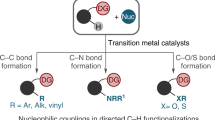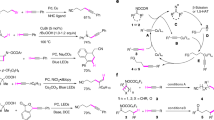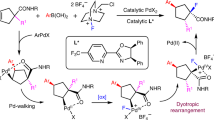Abstract
Despite the widespread success of transition-metal-catalysed cross-coupling methodologies, considerable limitations still exist in reactions at sp3-hybridized carbon atoms, with most approaches relying on prefunctionalized alkylmetal or bromide coupling partners1,2. Although the use of native functional groups (for example, carboxylic acids, alkenes and alcohols) has improved the overall efficiency of such transformations by expanding the range of potential feedstocks3,4,5, the direct functionalization of carbon–hydrogen (C–H) bonds—the most abundant moiety in organic molecules—represents a more ideal approach to molecular construction. In recent years, an impressive range of reactions that form C(sp3)–heteroatom bonds from strong C–H bonds has been reported6,7. Additionally, valuable technologies have been developed for the formation of carbon–carbon bonds from the corresponding C(sp3)–H bonds via substrate-directed transition-metal C–H insertion8, undirected C–H insertion by captodative rhodium carbenoid complexes9, or hydrogen atom transfer from weak, hydridic C–H bonds by electrophilic open-shell species10,11,12,13,14. Despite these advances, a mild and general platform for the coupling of strong, neutral C(sp3)–H bonds with aryl electrophiles has not been realized. Here we describe a protocol for the direct C(sp3) arylation of a diverse set of aliphatic, C–H bond-containing organic frameworks through the combination of light-driven, polyoxometalate-facilitated hydrogen atom transfer and nickel catalysis. This dual-catalytic manifold enables the generation of carbon-centred radicals from strong, neutral C–H bonds, which thereafter act as nucleophiles in nickel-mediated cross-coupling with aryl bromides to afford C(sp3)–C(sp2) cross-coupled products. This technology enables unprecedented, single-step access to a broad array of complex, medicinally relevant molecules directly from natural products and chemical feedstocks through functionalization at sites that are unreactive under traditional methods.
This is a preview of subscription content, access via your institution
Access options
Access Nature and 54 other Nature Portfolio journals
Get Nature+, our best-value online-access subscription
$29.99 / 30 days
cancel any time
Subscribe to this journal
Receive 51 print issues and online access
$199.00 per year
only $3.90 per issue
Buy this article
- Purchase on Springer Link
- Instant access to full article PDF
Prices may be subject to local taxes which are calculated during checkout





Similar content being viewed by others
References
Jana, R., Pathak, T. P. & Sigman, M. S. Advances in transition metal (Pd, Ni, Fe)-catalyzed cross-coupling reactions using alkyl-organometallics as reaction partners. Chem. Rev. 111, 1417–1492 (2011).
Tasker, S. Z., Standley, E. A. & Jamison, T. F. Recent advances in homogeneous nickel catalysis. Nature 509, 299–309 (2014).
Zuo, Z. & MacMillan, D. W. C. Decarboxylative arylation of α-amino acids via photoredox catalysis: a one-step conversion of biomass to drug pharmacophore. J. Am. Chem. Soc. 136, 5257–5260 (2014).
Lo, J. C., Gui, J., Yabe, Y., Pan, C.-M. & Baran, P. S. Functionalized olefin cross-coupling to construct carbon–carbon bonds. Nature 516, 343–348 (2014).
Zhang, X. & MacMillan, D. W. C. Alcohols as latent coupling fragments for metallaphotoredox catalysis: sp3–sp2 cross-coupling of oxalates with aryl halides. J. Am. Chem. Soc. 138, 13862–13865 (2016).
Margrey, K. A., Czaplyski, W. L., Nicewicz, D. A. & Alexanian, E. J. A general strategy for aliphatic C–H functionalization enabled by organic photoredox catalysis. J. Am. Chem. Soc. 140, 4213–4217 (2018).
Karimov, R. R. & Hartwig, J. F. Transition-metal-catalyzed selective functionalization of C(sp3)–H bonds in natural products. Angew. Chem. Int. Ed. 57, 4234–4241 (2018).
He, J., Wasa, M., Chan, K. S. L., Shao, Q. & Yu, J.-Q. Palladium-catalyzed transformations of alkyl C–H bonds. Chem. Rev. 117, 8754–8786 (2017).
Liao, K., Negretti, S., Musaev, D. G., Bacsa, J. & Davies, H. M. L. Site-selective and stereoselective functionalization of unactivated C–H bonds. Nature 533, 230–234 (2016).
Shaw, M. H., Shurtleff, V. W., Terrett, J. A., Cuthbertson, J. D. & MacMillan, D. W. C. Native functionality in triple catalytic cross-coupling: sp3 C–H bonds as latent nucleophiles. Science 352, 1304–1308 (2016).
Le, C., Liang, Y., Evans, R. W., Li, X. & MacMillan, D. W. C. Selective sp 3 C–H alkylation via polarity-match-based cross-coupling. Nature 547, 79–83 (2017).
Zhang, X. & MacMillan, D. W. C. Direct aldehyde C–H arylation and alkylation via the combination of nickel, hydrogen atom transfer, and photoredox catalysis. J. Am. Chem. Soc. 139, 11353–11356 (2017).
Heitz, D. R., Tellis, J. C. & Molander, G. A. Photochemical nickel-catalyzed C–H arylation: synthetic scope and mechanistic investigations. J. Am. Chem. Soc. 138, 12715–12718 (2016).
Shields, B. J. & Doyle, A. G. Direct C(sp3)–H cross coupling enabled by catalytic generation of chlorine radicals. J. Am. Chem. Soc. 138, 12719–12722 (2016).
Twilton, J. et al. The merger of transition metal and photocatalysis. Nat. Rev. Chem. 1, 0052 (2017).
Liu, D. et al. Nickel-catalyzed selective oxidative radical cross-coupling: an effective strategy for inert Csp3–H functionalization. Org. Lett. 17, 998–1001 (2015).
Hill, C. L. & Prosser-McCartha, C. M. in Photosensitization and Photocatalysis Using Inorganic and Organometallic Compounds (eds Kalyanasundaram, K. & Grätzel, M.) 307–330 (Springer, Dordrecht, 1993).
Renneke, R. F. & Hill, C. L. Homogeneous catalytic photochemical functionalization of alkanes by polyoxometalates. J. Am. Chem. Soc. 108, 3528–3529 (1986).
Renneke, R. F. & Hill, C. L. Selective photochemical dehydrogenation of saturated hydrocarbons with quantum yields approaching unity. Angew. Chem. Int. Ed. Engl. 27, 1526–1527 (1988).
Ravelli, D., Protti, S. & Fagnoni, M. Decatungstate anion for photocatalyzed “window ledge” reactions. Acc. Chem. Res. 49, 2232–2242 (2016).
Schultz, D. M. et al. Oxyfunctionalization of the remote C–H bonds of aliphatic amines by decatungstate photocatalysis. Angew. Chem. Int. Ed. 56, 15274–15278 (2017).
Halperin, S. D. et al. Development of a direct photocatalytic C–H fluorination for the preparative synthesis of odanacatib. Org. Lett. 17, 5200–5203 (2015).
West, J. G., Huang, D. & Sorensen, E. J. Acceptorless dehydrogenation of small molecules through cooperative base metal catalysis. Nat. Commun. 6, 10093 (2015).
Luo, Y.-R. Handbook of Bond Dissociation Energies in Organic Compounds (CRC Press, Boca Raton, 2003).
Ravelli, D., Fagnoni, M., Fukuyama, T., Nishikawa, T. & Ryu, I. Site-selective C–H functionalization by decatungstate anion photocatalysis: synergistic control by polar and steric effects expands the reaction scope. ACS Catal. 8, 701–713 (2018).
De Waele, V., Poizat, O., Fagnoni, M., Bagno, A. & Ravelli, D. Unraveling the key features of the reactive state of decatungstate anion in hydrogen atom transfer (HAT) photocatalysis. ACS Catal. 6, 7174–7182 (2016).
Gutierrez, O., Tellis, J. C., Primer, D. N., Molander, G. A. & Kozlowski, M. C. Nickel-catalyzed cross-coupling of photoredox-generated radicals: uncovering a general manifold for stereoconvergence in nickel-catalyzed cross-couplings. J. Am. Chem. Soc. 137, 4896–4899 (2015).
Ermolenko, L. P. & Giannotti, C. Aerobic photocatalysed oxidation of alkanes in the presence of decatungstates: products and effects of solvent and counter-ion of the catalyst. J. Chem. Soc. Perkin Trans. 2 6, 1205–1210 (1996).
Grynkiewicz, G. & Gadzikowska, M. Tropane alkaloids as medicinally useful natural products and their synthetic derivatives as new drugs. Pharmacol. Rep. 60, 439–463 (2008).
Hoshikawa, T., Yoshioka, S., Kamijo, S. & Inoue, M. Photoinduced direct cyanation of C(sp3)–H bonds. Synthesis 45, 874–887 (2013).
Bannon, A. W. et al. Broad-spectrum, non-opioid analgesic activity by selective modulation of neuronal nicotinic acetylcholine receptors. Science 279, 77–80 (1998).
Badio, B., Garraffo, H. M., Plummer, C. V., Padgett, W. L. & Daly, J. W. Synthesis and nicotinic activity of epiboxidine: an isoxazole analogue of epibatidine. Eur. J. Pharmacol. 321, 189–194 (1997).
de Oliveira Filho, R. E. & Omori, A. T. Recent syntheses of frog alkaloid epibatidine. J. Braz. Chem. Soc. 26, 837–850 (2015).
Acknowledgements
The research reported here was supported by the National Institutes of Health National Institute of General Medical Sciences (R01 GM103558-03) and gifts from MSD, Bristol-Myers Squibb, Eli Lilly, Genentech, Pfizer and Johnson & Johnson. The authors thank C. Kraml, N. Byrne and L. Wilson (Lotus Separations) for compound purification and I. Pelczer for assistance in structure determination.
Author contributions
I.B.P., T.F.B., P.J.S. and D.M.S. performed and analysed the experiments. I.B.P., T.F.B., P.J.S., D.M.S., D.A.D. and D.W.C.M. designed the experiments. I.B.P., T.F.B., P.J.S. and D.W.C.M. prepared the manuscript.
Author information
Authors and Affiliations
Corresponding author
Ethics declarations
Competing interests
The authors declare no competing interests.
Additional information
Additional information
Publisher’s note: Springer Nature remains neutral with regard to jurisdictional claims in published maps and institutional affiliations.
Supplementary information
Supplementary Information
This file contains Supplementary Text, Figures and Data; see contents page for details.
Rights and permissions
About this article
Cite this article
Perry, I.B., Brewer, T.F., Sarver, P.J. et al. Direct arylation of strong aliphatic C–H bonds. Nature 560, 70–75 (2018). https://doi.org/10.1038/s41586-018-0366-x
Received:
Accepted:
Published:
Issue Date:
DOI: https://doi.org/10.1038/s41586-018-0366-x
This article is cited by
-
Enantioselective synthesis of β- and α-amino ketones through reversible alkane carbonylation
Nature Synthesis (2024)
-
Metal-free photoinduced C(sp3)–H/C(sp3)–H cross-coupling to access α‑tertiary amino acid derivatives
Nature Communications (2023)
-
Photoelectrochemical oxidative C(sp3)−H borylation of unactivated hydrocarbons
Nature Communications (2023)
-
Acceptorless cross-dehydrogenative coupling for C(sp3)-H heteroarylation mediated by a heterogeneous GaN/ketone photocatalyst/photosensitizer system
Communications Chemistry (2023)
-
Selective C(sp3)–H arylation/alkylation of alkanes enabled by paired electrocatalysis
Nature Communications (2023)
Comments
By submitting a comment you agree to abide by our Terms and Community Guidelines. If you find something abusive or that does not comply with our terms or guidelines please flag it as inappropriate.



